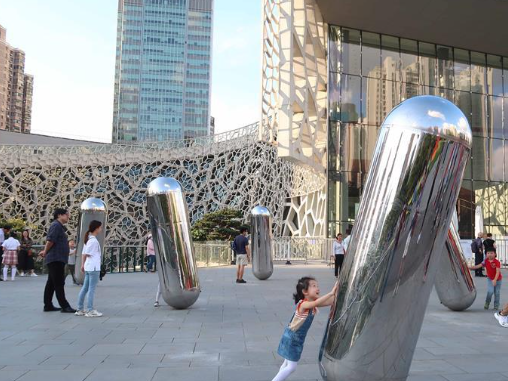
Public art, with its ability to transform mundane spaces into vibrant, engaging environments, plays a vital role in shaping communities and cities. Beyond mere aesthetics, public art has the power to inspire, provoke thought, and foster a sense of identity and belonging among residents. In this exploration, we delve into the significance of public art and how it enhances communities and spaces.
Aesthetic Transformation
Public art has a profound impact on the visual landscape of a community. It has the ability to transform blank walls, vacant lots, and nondescript structures into works of beauty. The aesthetic appeal of public art adds vibrancy and character to otherwise ordinary spaces.
- Beautification: Public art contributes to the beautification of neighborhoods and urban areas. Murals, sculptures, and installations can turn drab streets into engaging, colorful places.
- Iconic Landmarks: Public art often becomes a defining feature of a city. Iconic sculptures like the Statue of Liberty, Christ the Redeemer, or the Eiffel Tower are not just landmarks but also cultural symbols.
- Interactive Art: Some public art installations are interactive, inviting people to engage with and become part of the art. These experiences create lasting memories and connections.
Cultural Identity and Expression
Public art celebrates the unique cultural identity and heritage of a community. It tells stories, conveys values, and preserves traditions for future generations.
- Cultural Preservation: Many public art pieces reflect the history and heritage of a place. They serve as visual reminders of the community’s roots and evolution.
- Diversity and Inclusivity: Public art can represent the diverse backgrounds and perspectives of a community. It fosters inclusivity by honoring various cultural, ethnic, and social groups.
- Narrative of Change: Public art can serve as a narrative of change. It documents the progress and growth of a community, highlighting its resilience and adaptability.
Social Connection and Interaction
Public art brings people together and fosters social interaction. It serves as a meeting point, a backdrop for events, and a catalyst for conversation.
- Community Gatherings: Public art often becomes the focal point for community gatherings and events. Plazas, parks, and squares with art installations encourage social interaction.
- Conversation Starter: Art has the power to spark dialogue and debate. People may gather to discuss the meaning, symbolism, and significance of a particular piece.
- Shared Experience: Public art provides shared experiences. Residents and visitors can appreciate and engage with the art, creating connections among diverse groups.
Educational Value
Public art is an educational resource that enriches the lives of both residents and visitors. It offers lessons in history, culture, and art appreciation.
- Historical Insights: Public art can depict significant historical events, figures, or milestones. It serves as a visual history book for those who pass by.
- Art Appreciation: Exposure to public art can cultivate an appreciation for the arts, particularly among young people. It encourages creativity and cultural awareness.
- Local Stories: Public art can convey local stories and legends. Residents learn about their community’s past and folklore through art.
Inspiration and Creativity
Public art inspires creativity and imagination. It challenges conventional thinking and encourages individuals to see the world in new and innovative ways.
- Creative Expression: Artists often push the boundaries of creativity in public art. These works inspire others to explore their own creative potential.
- Unconventional Spaces: Public art transforms unconventional spaces into stages for artistic expression. Empty walls, utility boxes, and underpasses become canvases for creative ideas.
- Innovative Materials: Public art often involves the use of innovative materials and techniques, expanding the possibilities of what art can be.
Economic Benefits
Public art can have positive economic effects on communities. It attracts visitors, supports local businesses, and can increase property values.
- Tourism: Public art can be a tourist attraction. Visitors often seek out art installations, leading to increased foot traffic in local businesses.
- Cultural Tourism: Communities with a vibrant public art scene can become cultural tourism destinations. This brings in revenue and supports local economies.
- Property Values: The presence of public art can increase property values in a neighborhood or district, benefiting homeowners.
Environmental Impact
Public art can also have environmental significance. Some installations promote environmental awareness and sustainability.
- Eco-Friendly Art: Public art can incorporate sustainable and eco-friendly materials. It may promote environmental messages and encourage responsible practices.
- Green Spaces: Art installations can be integrated into green spaces and parks, enhancing the overall ecological health of an area.
Challenges and Considerations
While public art offers many benefits, it also comes with challenges and considerations:
- Funding: The creation and maintenance of public art can be expensive. Communities must consider how to fund these projects.
- Maintenance: Public art requires ongoing care and maintenance to ensure it remains in good condition. This can strain resources.
- Community Engagement: Decisions about public art should involve community input to ensure that the art resonates with residents.
- Controversy: Some public art may be controversial or provoke disagreement. Communities must navigate these issues diplomatically.
- Accessibility: Ensuring that public art is accessible to all, including people with disabilities, is an important consideration.
In conclusion, public art is a powerful force that enhances communities and spaces in numerous ways. From aesthetic transformation to cultural expression, social connection to economic benefits, and inspiration to environmental impact, public art enriches the lives of residents and visitors alike. While challenges exist, the positive impact of public art on communities and the broader public is undeniable, making it a valuable investment in the cultural and social well-being of society.
Leave a Reply